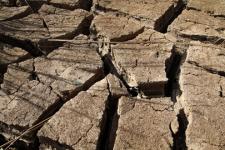
| Attachment | Size |
|---|---|
| 1-Drought_Impacts on Aguatic Ecosystem_Monash University Australia.pdf (6.2 MB) | 6.2 MB |
| 2-Drought_Drought Impact Report_University of Colorado.pdf (143.96 KB) | 143.96 KB |
| 3-Drought_Emergency Action_Ethiopia_Humanitarian Policy Group.pdf (567.34 KB) | 567.34 KB |
| 4-Drought_Emergency Action_Drought Management Advisory Council of North Carolina.pdf (2.54 MB) | 2.54 MB |
| 5-Drought_Mitigation_National Rainfed Area Authority_India.pdf (1.65 MB) | 1.65 MB |
| 6-Drought_Contingency Planning for Pastoral Livelihoods_University of Greenwich.pdf (478.88 KB) | 478.88 KB |
| 7-Drought_Contingency and Emergency Water Management Plan_City of Fort Worth Texas.pdf (1.07 MB) | 1.07 MB |
| 8-Drought_Early warning by satellite_USGS.pdf (1.31 MB) | 1.31 MB |
In general, drought is defined as an extended period - a season, a year, or several years - of deficient rainfall relative to the statistical multi-year average for a region. However, dozens of more specific drought definitions are used around the world that are defined according to the lack of rain over various time periods, or measured impacts such as reservoir levels or crop losses. Because of the various ways drought is measured, an objective drought definition has yet to be produced upon which everyone can agree[1].
Characteristics
Drought can be defined according to meteorological, hydrological, and agricultural criteria[2].
- Meteorological.
Drought is usually based on long-term precipitation departures from normal, but there is no consensus regarding the threshold of the deficit or the minimum duration of the lack of precipitation that make a dry spell an official drought.
- Hydrological
Drought refers to deficiencies in surface and subsurface water supplies. It is measured as stream flow, and as lake, reservoir, and ground water levels.
- Agricultural
Drought occurs when there is insufficient soil moisture to meet the needs of a particular crop at a particular time. A deficit of rainfall over cropped areas during critical periods of the growth cycle can result in destroyed or underdeveloped crops with greatly depleted yields. Agricultural drought is typically evident after meteorological drought but before a hydrological drought.
Impacts/damages
Impacts are commonly referred to as direct or indirect. Reduced crop, rangeland, and forest productivity; increased fire hazard; reduced water levels; increased livestock and wildlife mortality rates; and damage to wildlife and fish habitat are a few examples of direct impacts. The consequences of these impacts illustrate indirect impacts. For example, a reduction in crop, rangeland, and forest productivity may result in reduced income for farmers and agribusiness, increased prices for food and timber, unemployment, reduced tax revenues because of reduced expenditures, increased crime, foreclosures on bank loans to farmers and businesses, migration, and disaster relief programs. Direct or primary impacts are usually biophysical. Conceptually speaking, the more removed the impact from the cause, the more complex the link to the cause. In fact, the web of impacts becomes so diffuse that it is very difficult to come up with financial estimates of damages. The impacts of drought can be categorized as economic, environmental, or social.
Many economic impacts occur in agriculture and related sectors, including forestry and fisheries, because of the reliance of these sectors on surface and subsurface water supplies. In addition to obvious losses in yields in crop and livestock production, drought is associated with increases in insect infestations, plant disease, and wind erosion. Droughts also bring increased problems with insects and diseases to forests and reduce growth. The incidence of forest and range fires increases substantially during extended droughts, which in turn places both human and wildlife populations at higher levels of risk[3].
See also an example of the effects of drought on the aquatic ecosystem in Australia and Colorado.
Emergency Action
In order to assess risk and respond to drought, a water supplier may wish to establish a local drought management team. Be sure to include people from all the relevant local water user groups on the team[4] (see more details on the link). A team may:
gather all the available drought information for your community,
identify information gaps,
target water management needs,
implement water conservation strategies,
provide support to local government in managing community water supplies, and
communicate with the public.
See also the action on responding to drought in pastoral areas of Ethiopia and the North Carolina emergency response plan.
Mitigation
The mitigation action identifies both the long and short term activities and actions that can be implemented to prevent and mitigate drought impacts. Such activities and actions are essential in the development of specific drought planning and response efforts. The operational component includes six aspects that need continuous feedback between them[5]:
Preparedness, early warning, monitoring systems.
Establishing priorities of water use.
Defining the conditions and the thresholds to declare drought levels.
Establishing the management objectives in each drought level.
Defining the actions.
Implementation of actions.
Monitoring and preparedness planning is the first essential step for moving from crisis to risk management in response to drought, and can be viewed as permanent measures to cope with drought events. The management actions related to agriculture and water supply systems are presented with a common conceptual framework based on the use of drought indices for evaluating the levels of drought risk (pre-alert, alert, and emergency), that allow linkages to be established between science (risk analysis) and policy (operational component).
See also drought mitigation policy in South Africa in Water Page and drought mitigation strategy for Bundelkhand region of Uttar Pradesh and Madhya Pradesh in India.
Further information
Several actions related to drought management plans:
- Drought contingency planning for pastoral livelihoods. (click here)
- Drought Contingency and Emergency Water Management Plan in Texas. (click here)
- Drought management guidelines in Mediterranean countries. (click here)
- Information about satellite observation and rainfall forecast to provide earlier warning of African drought by USGS.
[1] http://earthobservatory.nasa.gov/Features/DroughtFacts/
[2] http://earthobservatory.nasa.gov/Features/DroughtFacts/
[3] http://www.drought.unl.edu/risk/impacts.htm
[4] http://www.env.gov.bc.ca/wsd/public_safety/drought_info/cabinet/drought_handbook2009V2.pdf
[5] http://www.iamz.ciheam.org/medroplan/guidelines/operational.html
